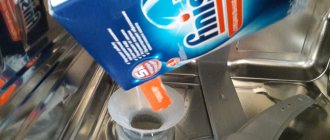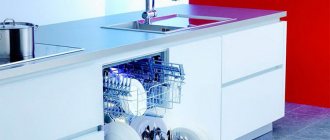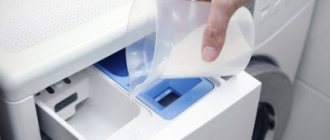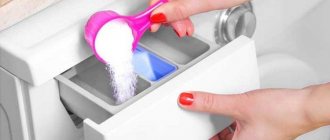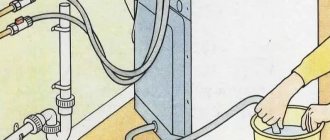For many years of trouble-free operation of a dishwasher (DMM), it is necessary to use not only washing powders, gels and rinse aids. The unit must be periodically refilled with regenerating salt. Each model has a special compartment for this chemical. Recommendations on how to choose a product, where and how much salt to pour into the dishwasher are standard for all appliances, regardless of brand and year of manufacture.
Why is salt needed?
Water used for drinking and domestic purposes always contains salts of dissolved alkaline earth metals - calcium and magnesium. The concentration of these compounds indicates increased or decreased water hardness: the higher it is, the harder the water flows from the tap and vice versa.
During the operation of technical devices, the operation of which is directly related to the heating of water, the formation of scale, limescale and deposits occurs. They worsen the technical characteristics of units and can lead to deformation and breakage of individual parts and assemblies.
To avoid such troubles, manufacturers have provided a special compartment - an ion exchanger, which contains a synthetic ion exchange resin. The purpose of this device is to soften water by attracting magnesium and calcium ions dissolved in water.
Passing through an ion exchanger, the water is completely purified from harmful impurities. But to restore the ion-exchange properties of the resin, the constant presence of sodium chloride is necessary, of which 98% consists of the regenerating salt for PMM. The remaining 2% are various chemical compounds intended to give the product a marketable appearance, disinfectant properties and aroma.
Salt softens water, prevents the formation of smudges, limescale and scale on the parts of the device, and extends the service life of the unit.
It makes it easier to wash out difficult stains from plates and glasses, ensuring the cleanliness and shine of washed dishes, which do not leave unsightly streaks and stains.
Choice of product
The first step in softening water is choosing the right product. Among the entire range of products, the following types are especially popular:
- special regenerating compounds – Somat, Finish, Calgonit;
- products in tablet form – Topperr;
- bleached household substitute of the “Extra” grade;
- 3-in-1 tablets.
3-in-1 tablets contain sodium chloride concentrate. It effectively restores ions in the ion exchanger and helps reduce water hardness
A quality product must contain the following components:
- sodium percarbonate;
- flavoring components;
- sodium citrate, which has an antimicrobial effect;
- sodium bicarbonate and disilicate;
- polyaspaginate - this ingredient is designed to restore and preserve ions in the ion exchanger.
Do not use kitchen salt in your dishwasher. It contains impurities that negatively affect the operation of the device and lead to rapid wear of working parts. In addition, it does not have the desired effect in purifying water and restoring ions.
The rules of use and dosage of the products are indicated on the packaging. Before use, carefully read the instructions and recommendations of the manufacturer.
How to choose
The range of dishwasher salts produced is large, so every consumer will be able to choose products to suit their taste and budget. The most popular variety is considered to be a granular (crystalline) product packaged in cardboard boxes or plastic bags. The drug with regenerating properties is produced by all leading manufacturers of household chemicals for PMM:
- Clean & Fresh.
- Gut & Günting.
- Elly.
- Finish.
- Kraft.
- Largo.
- Magic Power.
- O'Key.
- Paclan Brileo.
- Somat.
- Start.
- Sanit.
- Top House.
Another form of release is tableted salt for the dishwasher, in the form of bulk tablets. Such products are represented on the market by several brands:
- Dr.Prakti.
- Frau Schmidt.
- Lotta.
- Kristall-fix.
- Tortilla.
- Topper.
Some housewives are trying to save money on the family budget, so instead of a special product they use table salt of different grinds. This should not be done under any circumstances, since over time the ion exchanger and other parts of the dishwasher will become clogged with foreign impurities present in the uncleaned kitchen product, fail and require expensive repairs.
The purpose of dishwasher salt and its functions
container for specialized salt in the dishwasher
In most regions of the Russian Federation, hard water flows from taps, that is, with a high content of calcium and magnesium. And since the operation of the dishwasher is interconnected with the water supply, to prevent a number of unpleasant consequences, special salt should be poured into it.
Putting salt in the dishwasher is necessary to perform the following tasks:
- preventing the appearance of smudges and stains on washed dishes;
- ensuring the removal of limescale from glass and metal surfaces of plates and other kitchen utensils;
- softening hard water;
- this product prevents the formation of scale on the working parts of the dishwasher, which contributes to its breakdown;
- salt allows you to maintain the functioning of the ion exchanger, which is responsible for softening the water in the PMM, by replenishing the sodium supply.
Sodium is part of a synthetic resin that prevents calcium and magnesium from combining. The reaction of these two chemicals causes limescale deposits to form on surfaces.
At its core, special (regenerating) dishwasher salt is ordinary table salt consisting of sodium chloride (NaCl).
But one significant detail prevents it from being used as a water softener in the dishwasher. Regular salt contains a suspension , which can settle over time and crystallize in a tank for feeding it to the ion exchanger. And then prevent sodium-rich water from entering it. Therefore, excessive savings on professional products, which are usually sold in the form of granules cleared of impurities, can result in damage to household appliances.
To avoid scale formation on the heating element of household appliances - heating element, use only specialized salt for dishwashers.
How much to pour
The question of how much salt to pour into the dishwasher always worries those who start the machine for the first time. Manufacturers recommend a full load, that is, loading the bunker with salt to the top level. An average of 0.7 to 1.3 kg of softening component is placed in the compartment.
Judging by numerous user reviews, it is enough to fill a standard kilogram pack of salt once, and even with daily use of the PMM it will last for 1.5-3 months. The next filling of the softening agent must be carried out immediately after the no-salt indicator located on the digital display lights up.
How much salt is enough and how often you have to add it depends on the hardness of the water in the region. The easiest way to determine this is to call your local water and sewer company. The second accessible and more or less accurate way is to use a table or map of water hardness by region of Russia, compiled by specialists.
Salt consumption will be greater in the south and center of the European part of the country, as well as in the southern regions of Western Siberia. Residents of the northern European part of Russia and Eastern Siberia are luckier, since soft water flows from their taps in their homes.
Based on the results of determining water hardness, it is necessary to set the level of salt consumption.
Expensive branded models have a special sensor installed that automatically detects water hardness and adjusts the operation of the ion exchange device.
In budget machines, this function will have to be configured manually.
This procedure is described in detail in the dishwasher instructions and takes just a few minutes. Almost all models have a scale from 0 to 7, where 0 is super-soft water, and 7 is super-hard. By default, in most PMMs the hardness value is set to the middle position, but with the help of 2-3 buttons and a few clicks it can be easily changed up or down.
How water hardness level affects salt consumption
Here the relationship is direct: the harder the water, the more chlorine ions are needed to soften it in the ion exchanger. Therefore, before using your dishwasher, you need to find out how hard the tap water you are using is.
In Russia, the level of water hardness is measured in degrees (°Zh). One degree corresponds to a concentration of magnesium and calcium salts equal to 0.5 millimoles in a volume of liquid of 1 liter, or 1 mEq/l. It should be noted that water hardness is measured differently in different countries. For example, one Russian °Zh is equal to 2.8 German degrees (dH).
A schematic representation of the water cycle in nature shows at what stage magnesium and calcium salts enter the liquid
In different regions of Russia, water can vary greatly in the level of Mg and Ca compounds. It all depends on the soils in which the beds of streams, rivers and lakes are located. Water is divided according to its hardness level:
- for soft – the salt content does not exceed 3°F;
- for medium-hard – from 3 to 6°F;
- for hard – 6–10°F;
- for very hard – more than 10°F.
Hard liquid causes irreparable damage to both household appliances and plumbing systems. To calculate this indicator, you can use specially made test strips. You can buy them at any pharmacy. In some dishwasher models, such strips are included with the appliance.
Test strips for measuring water softness levels
Based on the test result and the recommendations of the instructions supplied with the equipment, it is necessary to set the sodium chloride consumption level to soften the liquid. For example, some models of Bosch dishwashers allow you to set up to 7 different values on the control panel, depending on the amount of Ca and Mg compounds in the liquid.
3-in-1 dishwashing tablets containing detergent, rinse aid and water softener
In conclusion, I would like to give advice to novice users: do not pay attention to advertising gimmicks or “7-in-1” used in PMM. They contain a softener, but it is not enough for the dishwasher to work properly. The salt composition must be poured into the ion exchanger hopper to maintain its performance, regardless of what type of detergent is used to wash dishes.
Where to sleep
Before using the dishwasher for the first time, you should carefully study the instructions for using the unit. Manufacturers provide it with a detailed description of the technical characteristics, the device itself and the features of its operation.
Each unit has a special hole that opens the entrance to the salt bin. In dishwashers Bosch, Electrolux, Candy, Hotpoint-Ariston and other models of different price categories, the compartment is located at the bottom of the chamber under the lower container for dishes. The entrance to the ion exchange device is closed with a plastic screw cap, which must be unscrewed and returned to its place after adding the softener.
The indicator lights up - it’s time to pour salt
The dishwasher itself signals when it is time to add sodium chloride to the filter. A red light on the panel lights up opposite the icon with arrows diverging in different directions:
Having noticed a signal, you need to take action.
How to add salt correctly:
- Open the dishwasher door and find the filter cover at the bottom.
- Unscrew and insert the funnel into the hole.
- Pour 1 liter of water.
- Pour in 0.7–1 kg of salt.
- We clean up everything that spills and spills out with a sponge.
- Screw on the lid.
The process of reducing the ion exchange resin is completed when the solution becomes homogeneous.
It is better to load the product immediately before using the dishwasher. During operation, the remaining brine solution will be washed away. Contact with metal is not advisable due to the risk of corrosion.
How to fall asleep
Manufacturers equip dishwashers with special large-diameter funnels. This device makes it easier to load salt and prevent crystals from scattering along the bottom of the working chamber. Experts advise that before pouring salt into Electrolux, Simens, Beko or other PMM for the first time, pour 1-1.5 liters of clean water into the compartment. As the bunker is filled with salt, excess liquid will flow down the drain, but crystals and granules will not stick to the walls of the ion exchanger. In the future, you will no longer have to do this, since the machine itself will take care of filling the compartment with water.
Forms of release of regenerating agents
Manufacturers of various products used in dishwashers produce universal dishwashing tablets - “10 in one”, “7 in one”, etc. Some of them contain a small amount of special salt. However, this amount is not enough to maintain normal sodium levels in the ion exchanger. The solution in this situation is obvious - add additional professional salt.
Like dishwashing detergents, manufacturers offer special salt in a variety of forms:
- Powdered or granular regenerating agents.
- Salt compressed into tablets.
When choosing a specific product, you need to be guided by the composition that the manufacturer indicates on the packaging of the regenerating salt. A smaller amount of various impurities and additives in it will give the most effective result.
How to determine when it’s time to add salt to the PMM
Typically, PMMs are equipped with a salt indicator, which signals that it is time to put a new portion of this substance into the appropriate container. This indicator will glow constantly; to turn it off, pour the required salt solution there. The indicator can most often be identified by a pictogram of arrows intertwined in the shape of the letter S. In general, so that there is no doubt about this issue, it is better to study the dishwasher’s operating manual - there are descriptions of all the indicators and settings.
What to do if there is no indicator
Some models do not have an indicator. In this case, a signal that it is time to replenish the salt compartment is a decrease in the quality of dishwashing - a residue may remain on the utensils, which is especially noticeable on products made of transparent colorless glass. In such a situation, it is recommended to observe the dishwashing processes and determine the approximate time when a clear decline in quality begins. Then you just need to sprinkle the salt solution without waiting for a coating to appear on the dishes.
How to replace a special salt product
The main component of special salt granules or tablets is sodium chloride, i.e. ordinary table salt - they contain about 99%. In principle, you can replace the special substance with table salt from the store. The best option for this would be the “Extra” variety - this variety is considered the purest. But you should know that dishwasher manufacturers categorically do not recommend replacing special components with food grade ones.
The fact is that table salt usually contains various impurities that negatively affect the performance of the PMM. Of course, it will not fail immediately, but its service life may be greatly reduced. In addition, special salt products, in addition to sodium chloride, usually include additional beneficial substances - these can be antibacterial additives and flavorings.
For owners of Bosch dishwashers
Let us give examples from the instructions for the Bosch brand PMM, from which it is clear that it is necessary to use salt.
Hardness reducing device
In order for the washing to take place at the proper level, purified water, without calcium salts, must be supplied to the machine. Otherwise, scale will appear on the walls, dishes and parts of the machine. Water with high calcium hardness must undergo a purification procedure before reaching important parts of the device. To soften the water, a device built into the body of the machine is used; salt is poured into it.
What kind of salt for PMM is on the market?
You can put different types of salt compositions into the dishwasher - they differ in release form, price, and effectiveness. Among the proposed options, four are worth highlighting:
- Special salt compositions. Made for PMM. Brands Finish, Somat, Magic Power and others.
- Pills. For example, Topperr. Economical solution.
- Boiled salt "Extra". Inexpensive substitute for special equipment.
- "Extra" in tablets.
What does the manufacturer offer?
- A special product for restoring the ion exchanger - Finish, Calgonit, Somat or others.
- Tablet preparations - Topperr.
- Evaporated salt composition "Extra".
- Tablets based on "Extra".
Before using this or that product, be sure to read the instructions - usually the manufacturer indicates right on the packaging how much to put in the dishwasher.
Do you need salt when washing with tablets?
When you have a dishwasher for the first time, at the initial start-up you have not yet decided what detergents you will use. You might prefer powder, which means you definitely need salt. What if you wash with combined tablets? They already contain both rinse aid and salt - why add it additionally?
If the water in your area is soft, crystals are also useful: turn off the softener and set it to zero. The salt will maintain the condition of the ion exchange resin for years, and scale will never form.
For medium to very hard water, always add crystals! And adjust the ion exchanger settings. This will allow you to easily alternate detergents - powder and tablets.
Loading salt for the first time is a responsible and simple process. Even if you make a slight mistake when setting up the softener or do not add enough crystals, it is important that there are some in the compartment. When you need to add, the dishwasher will tell you - watch the sensors on the panel.
